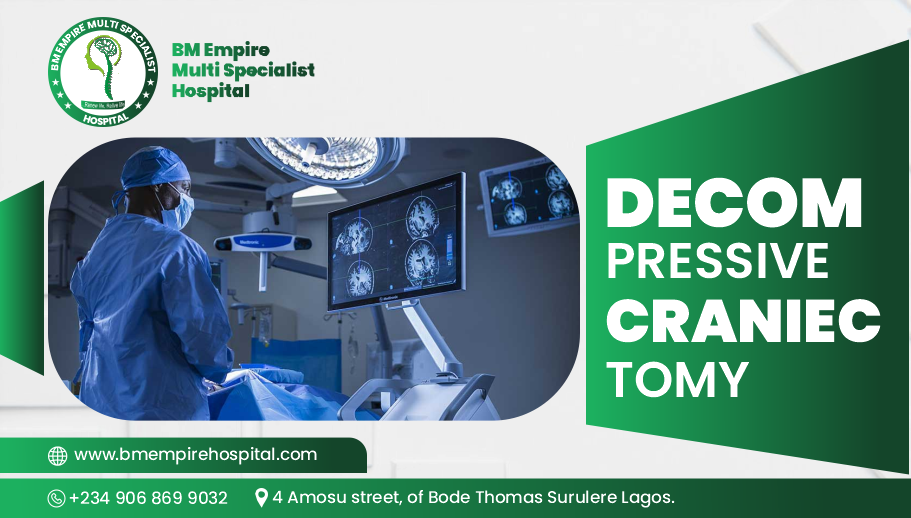Decompressive craniectomy is a critical neurosurgical procedure designed to relieve pressure on the brain caused by various medical conditions. This procedure can be life-saving and significantly improve patient outcomes. In this blog post, we will discuss the causes that may necessitate a decompressive craniectomy, prevention strategies, an overview of the surgical procedure, and how to manage post-operative care. We will also highlight why BM Empire Multispecialist Hospital is the leading choice for neurosurgery in Lagos.
Causes for Decompressive Craniectomy
Decompressive craniectomy is typically performed in response to conditions that lead to increased intracranial pressure, including:
Traumatic Brain Injury (TBI): Severe head injuries can cause swelling or bleeding in the brain, necessitating a reduction in pressure.
Stroke: Ischemic or hemorrhagic strokes can lead to swelling and increased pressure in the cranial cavity.
Brain Tumors: Tumors can cause localized swelling and increased intracranial pressure, requiring intervention.
Hydrocephalus: An accumulation of cerebrospinal fluid (CSF) in the brain’s ventricles can lead to increased pressure, and a craniectomy may be necessary to alleviate it.
Infections: Severe infections, such as encephalitis or abscesses, can lead to brain swelling, prompting the need for decompression.
Prevention Strategies
While not all causes of increased intracranial pressure can be prevented, certain strategies can help mitigate risks:
Protective Gear: Always wear helmets and appropriate protective gear during sports or activities that pose a risk of head injury.
Fall Prevention: Implement safety measures in homes, especially for the elderly, to minimize the risk of falls.
Control Risk Factors: Managing underlying health conditions, such as hypertension or diabetes, can reduce the risk of stroke and related complications.
Seek Immediate Care: Prompt medical attention for head injuries or sudden neurological symptoms can prevent worsening conditions.
The Decompressive Craniectomy Procedure
The decompressive craniectomy procedure involves several key steps and is usually performed under general anesthesia:
Pre-operative Assessment: The neurosurgeon will evaluate the patient’s medical history and conduct imaging studies (CT or MRI scans) to determine the need for surgery and the extent of brain swelling.
Anesthesia: General anesthesia is administered to ensure the patient is unconscious and pain-free during the procedure.
Surgical Preparation: The surgical area is cleaned and sterilized to reduce the risk of infection.
Incision: The surgeon makes an incision in the scalp, typically in a way that minimizes cosmetic impact, and removes a section of the skull (the cranium) to expose the brain.
Decompression: The surgeon carefully removes any tissue or fluid causing pressure on the brain. This may involve aspirating blood or pus if present.
Closure: The removed section of the skull may be stored for later replacement, or the area may be covered with a protective material. The incision is then closed with sutures or staples.
Post-operative Management
Proper post-operative care is essential for recovery:
Monitoring: Patients are closely monitored in the hospital for any signs of complications, such as infection, re-bleeding, or neurological changes.
Pain Management: Pain relief medications will be prescribed to help manage discomfort after surgery.
Rehabilitation: Depending on the underlying condition and the extent of the surgery, physical therapy or occupational therapy may be required to aid recovery.
Activity Restrictions: Patients should avoid strenuous activities, heavy lifting, and driving for a specified period as they heal.
Follow-up Appointments: Regular follow-up visits with the neurosurgeon are crucial for monitoring recovery and assessing any ongoing issues.
Signs of Complications: Be vigilant for signs of infection, increased headache, or any changes in neurological status, and seek medical attention if these occur.
Why Choose BM Empire Multispecialist Hospital?
For those in need of decompressive craniectomy or other neurosurgical interventions, BM Empire Multispecialist Hospital is the most preferred facility in Lagos. Located at 4, Amosu Street, Bode Thomas, Surulere, we offer:
Expert Care: Our experienced team of neurosurgeons is dedicated to providing the highest quality of care using the latest techniques and technology.
Comprehensive Services: We provide a wide range of neurosurgical interventions, ensuring that all patient needs are addressed in one location.
Patient-Centric Approach: We prioritize your comfort and education throughout your treatment journey, ensuring you are well-informed at every stage.
Conclusion
Decompressive craniectomy is a crucial procedure for managing increased intracranial pressure and can significantly improve patient outcomes. Understanding the causes, the surgical process, and the importance of aftercare can greatly enhance recovery. For expert neurosurgical care in Lagos, look no further than BM Empire Multispecialist Hospital. Chat Us on WhatsApp or call 09068699032

